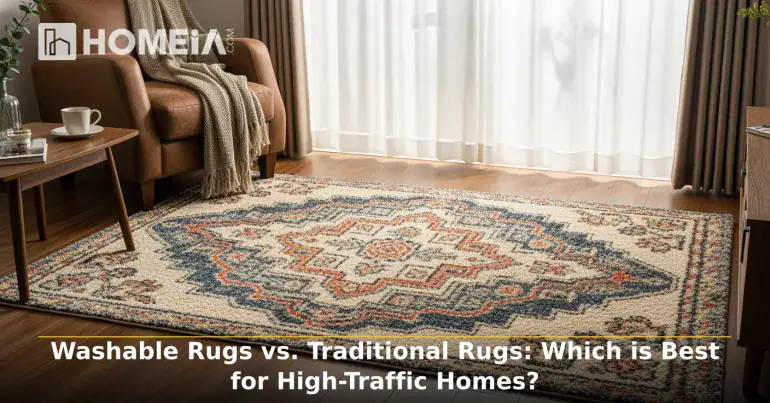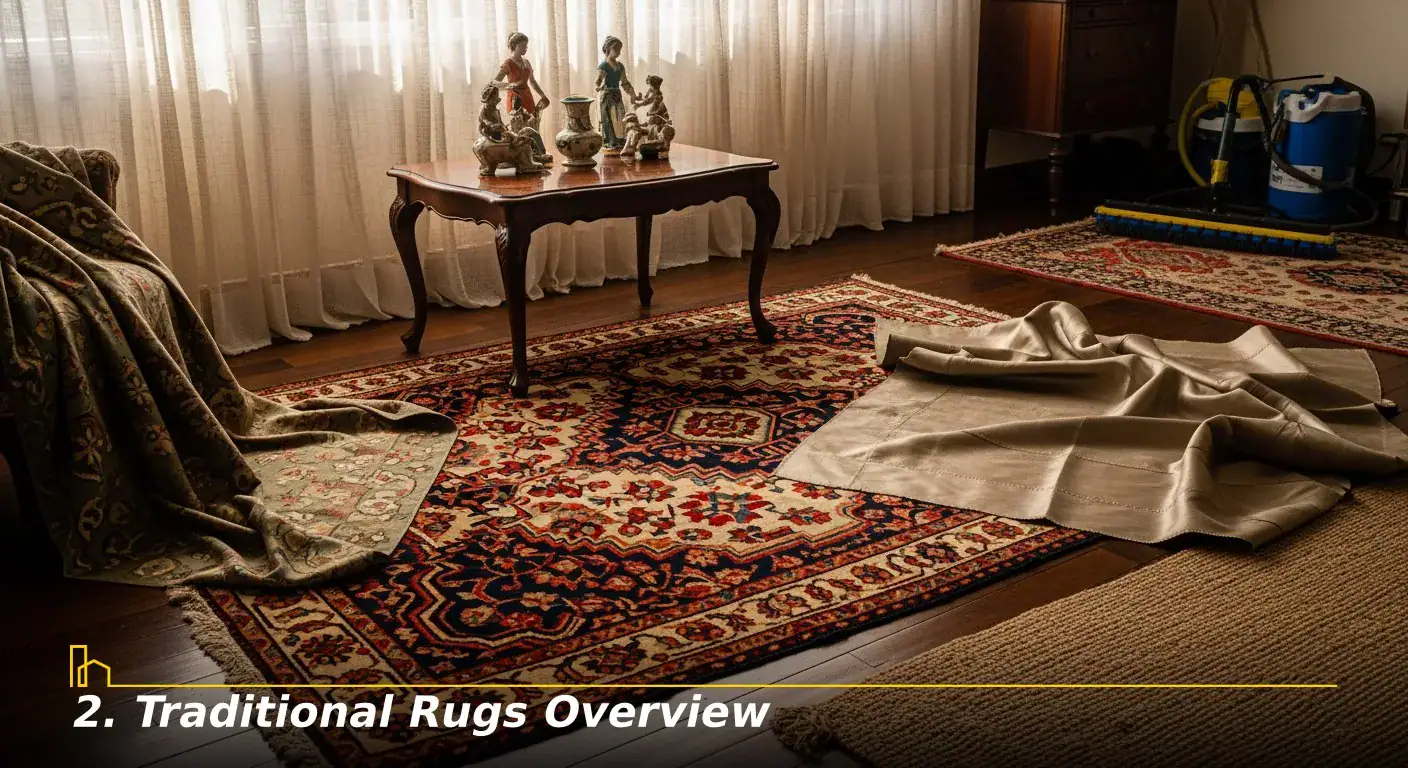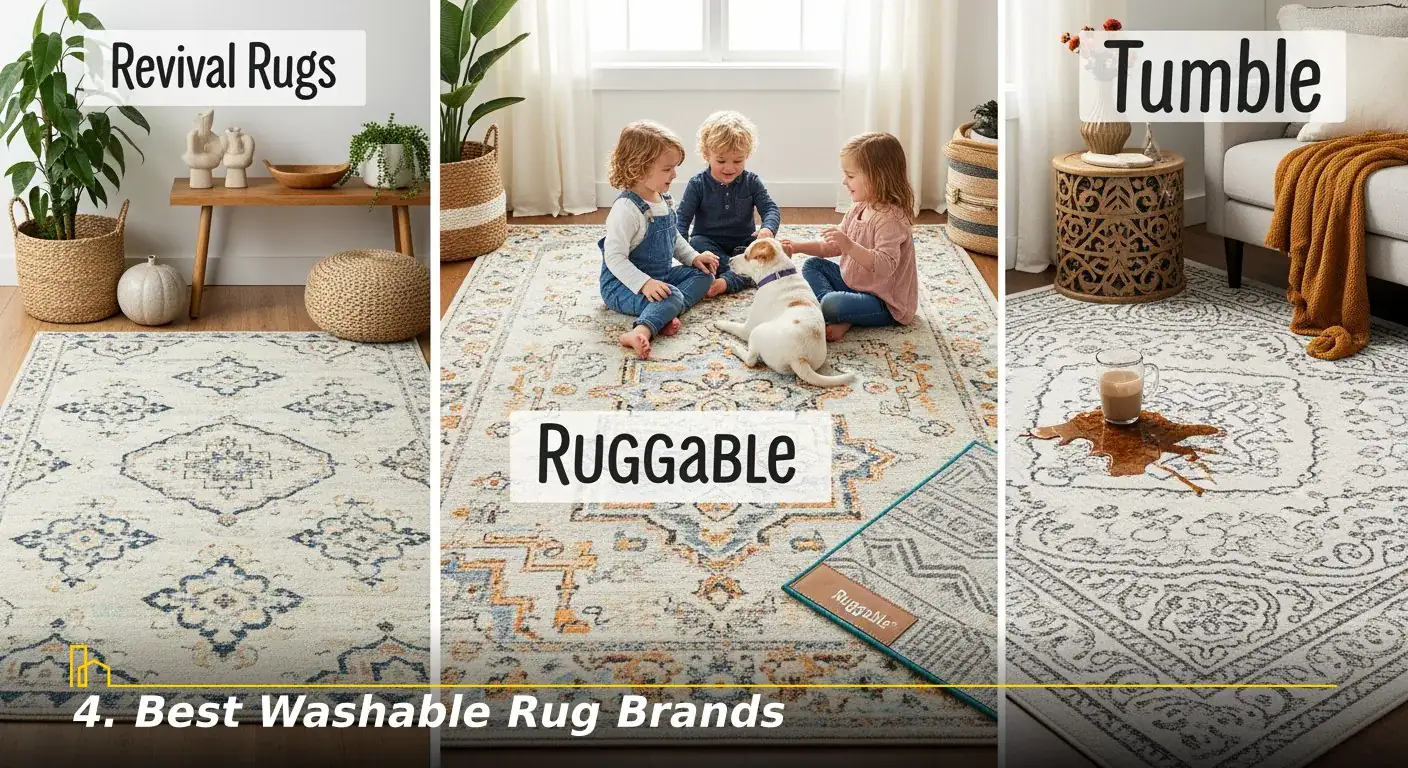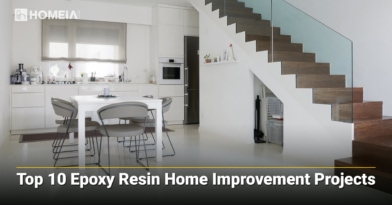Washable Rugs vs. Traditional Rugs: Which is Best for High-Traffic Homes?
- Local Editor:Local Editor: The HOMEiA Team
Published: Nov 06, 2025
- Category: Home Improvement

Picture this: red wine crashes to the floor, spreading across your expensive traditional rug. Despite frantic blotting, a faint shadow will remain. This nightmare plays out daily in homes with children, pets, or active lifestyles.
The global carpets and rugs market, valued at $64.19 billion in 2025, reflects shifting consumer priorities toward practical yet stylish solutions. With 71% of U.S. households (94 million homes) owning pets, and millions of families with young children, demand for functional home decor is at an all-time high.
Washable rugs represent a significant shift in home furnishings. No longer limited to thin, utilitarian mats, today’s washable options offer design-forward aesthetics with revolutionary care requirements. This guide compares washable and traditional rugs across durability, comfort, design, cost, maintenance, and environmental impact to help make the right choice.
Table of Contents:
Key Takeaway
Washable rugs are revolutionizing home decor by blending style with unrivaled convenience. This has become a fan-favorite for busy households with kids, pets, or allergy concerns. While traditional rugs can last several decades and offer timeless craftsmanship, modern washable rugs are their newest competitor in design and deliver clear advantages with ease-of-care and cost. For high-traffic spaces or those needing frequent cleaning, washable rugs provide practical, budget-friendly solutions without sacrificing aesthetics. Ideally, households will contain both: enjoy heirloom traditional rugs in low-traffic rooms and place washable options wherever regular spills, stains, or heavy use are likely. Choose based on your lifestyle needs for a clean, comfortable, and stylish home.
Top 10 Epoxy Resin Home Improvement Projects
Thanks to its ease of use—just combine the two liquids in the correct ratio and mix thoroughly and you’re ready to work—you can use epoxy resin for a variety of applications. Here we’ve gathered 10 ideas to get you started...1. What Are Washable Rugs?

Washable rugs are machine-cleanable floor coverings designed for standard household washing machines. There’s two approaches for these: a two-piece system with removable rug cover attached to a non-slip pad (brands like Ruggable), or integrated washable designs cleaned as complete units.
Key Features:
- Materials: Polyester, nylon, recycled plastic, organic cotton, and washable wool
- Size limitation: Most max out at 8×10 feet for home machines
- Technology: Spillproof coatings, non-slip backings, non-toxic certifications (OEKO-TEX)
- Leading brands: Ruggable, Tumble, Revival Rugs
Lifespan: High-quality washable rugs last 3-5 years with average use, though premium options with organic cotton or washable wool can last 10-15 years. They can withstand 50-100 washes before showing significant wear.
2. Traditional Rugs Overview

Traditional rugs are non-machine-washable floor coverings featuring natural fibers such as wool, silk, cotton, jute, and sisal. They’re distinguished by hand-knotted, hand-tufted, or hand-woven craftsmanship contributing to their longevity.
Material Benefits:
- Wool rugs: Can last 50+ years with proper care and professional cleaning due to natural resilience. According to wool rug experts at Rug Source, quality wool construction is one of the most durable investments in home furnishings.
- Silk rugs: Luxury heirlooms requiring low-traffic placement
- Plant-based fibers: Organic texture but challenging stain removal
Maintenance ranges from $300 for basic wool area rugs to $20,000+ for fine silk hand-knotted pieces. The value proposition centers on artisanal craftsmanship, natural material benefits, and timeless design appeal.
Top 3 Home Design Trends
The minimalist styles that have saturated the design market are giving way to warmer, more soothing environments. Rising trends show that people are looking for inviting styles where comfort is king. Here are 3 Home Design Trends Gaining Popularity...3. Head-to-Head Comparison

A. Durability & Longevity
- Traditional Rugs: High-quality wool rugs last 50+ years, becoming potential heirlooms. Hand-knotted construction creates inherently durable structures that develop desirable patina over time. Wool’s natural resilience allows it to rebound from foot traffic compression.
- Washable Rugs: Typical lifespan is 3-5 years, varying by material and washing frequency. Polyester and synthetic blends wear faster than natural fibers. However, organic cotton washable rugs can last 10-15 years. Washable wool options may provide 15-20 years with appropriate care. Frequent cleaning maintains a “like-new” appearance but gradually decreases fiber integrity.
- Verdict: Traditional rugs win for absolute longevity; washable rugs excel at maintaining original appearance throughout their shorter lifespan.
B. Comfort & Feel Underfoot
- Traditional Rugs: Wool provides supremely soft, plush comfort with natural temperature-regulating properties. High-pile shag options deliver luxurious textures adding warmth and acoustic softening. Handwoven textures create unique tactile experiences.
- Washable Rugs: Entry-level options often feel thin and flat. However, premium exceptions are available: Revival Rugs’ Taylor offers high-pile shag, while Crate & Kids’ Ember features varied pile heights. Tumble includes cushioned non-slip rug pads (1/4″ thick) for added comfort. Polyester blends feel soft but offer less breathability than natural fibers.
- Verdict: Traditional rugs maintain overall comfort advantage, but washable choices are continually improving with premium innovations.
C. Design & Style Options
- Traditional Rugs: Virtually unlimited designs encompassing Persian medallions, Moroccan geometrics, and abstract artisanal patterns developed over centuries. Hand-illustrated patterns feature natural color variations from traditional dyeing techniques. Custom sizing available from artisan makers.
- Washable Rugs: Design quality improved dramatically within the past five years. Revival Rugs’ Hana collection features art-inspired designs influenced by Korean Dansaekhwa movement and Mark Rothko. Ruggable provides 500+ designs with designer collaborations. High-low pile textures (Rugs USA’s Fredrika) create visual dimension.
- Verdict: Traditional rugs maintain edge in artisan craftsmanship; washable rugs offer aesthetic appeal with expanding designer collaborations.
D. Cost Analysis (20-Year Total Ownership)
Cost Factor | Traditional Rugs | Washable Rugs |
|---|---|---|
| Initial Purchase (8×10) | $300–$2,000 (wool) | $150–$300 |
| Annual Maintenance | $200–$500 (professional cleaning) | $0 (home washing) |
| Replacement Cycle | 20+ years | 5–10 years |
| 20-Year Total Cost | $2,700+ | $900 or less |
Verdict: Washable rugs provide dramatically lower total cost of ownership, offering $1,800+ savings over two decades.
E. Maintenance & Cleaning Ease
- Traditional Rugs: Require weekly vacuuming (no beater bar for wool/silk), immediate spot cleaning with club soda or mild soap, professional deep cleaning annually or biannually ($100–$300), quarterly rotation, and moth protection for wool.
- Washable Rugs: Machine wash cold on gentle cycle following manufacturer specifications. Air dry or low-heat tumble dry. Wash every 2–4 weeks for pet/kid homes, quarterly otherwise. Ruggable systems require washing only the separate cover.
- Verdict: Washable rugs provide game-changing maintenance advantage for busy households.
F. Environmental & Health Considerations
- Traditional Rugs: Natural fibers (wool, cotton, jute) are biodegradable. Wool offers natural antimicrobial and hypoallergenic benefits, though removing allergens requiring frequent deep cleaning. Sustainability depends on responsible sourcing (FSC, fair trade).
- Washable Rugs: Owners utilize recycled plastic materials, diverting waste from landfills. Frequent washing capability gets rid of antigens effectively—major benefit for allergy/asthma sufferers. Organic cotton options are fully biodegradable. Synthetic polyester not biodegradable, creating landfill concern.
- Verdict: Tie—traditional natural fiber rugs win for sustainability; washable rugs provide superior allergy management.
Recommended for you
4. Best Washable Rug Brands

A. Ruggable
- System: Two-piece (rug cover + non-slip pad)
- Designs: 500+ options with designer collaborations
- Sizes: 2×3 to 9×12
- Price: $80–$600
- Pros: Maximum design variety, interchangeable covers, excellent non-slip pad
- Cons: Classic rugs very thin (2mm); premium pads cost extra
- Best For: Design variety seekers, households with pets/kids
B. Revival Rugs
- Materials: Organic cotton and washable wool
- Collections: Taylor (high-pile shag), Hana (art-inspired), Recess (100% organic cotton)
- Price: $99–$2,499
- Pros: Natural fibers, unexpected textures, sustainable production
- Cons: Higher price point, limited design selection vs. Ruggable
- Best For: Natural fiber enthusiasts, eco-conscious buyers, comfort seekers
C. Tumble
- Features: Spillproof, includes cushioned non-slip pad (1/4″ thick)
- Designs: Hand-illustrated exclusive patterns
- Sizes: 3×5 to 8×10
- Price: $150–$500
- Pros: OEKO-TEX certified, integrated cushioning, exceptional spill protection
- Cons: Fewer design options, smaller size range
- Best For: Families with young children, spill-prone areas (kitchens, dining rooms)
How to Select the Best Oak Coffee Table for Your Home — Expert Tips
In this article, we’ll explore how you can select the best oak coffee table for your home. We’ll cover everything from understanding the nuances of oak as a material, harmonizing it with your living space, and balancing functionality with aesthetic appeal…
5. When to Choose Traditional Rugs

Traditional rugs remain superior for:
- Formal living rooms and dining rooms with low traffic patterns where craftsmanship becomes a focal point
- Investment/heirloom pieces to pass to future generations—hand-knotted wool rugs can appreciate in value
- Adult-only households or empty nesters without pets where cleaning demands decrease
- Authentic artisan craftsmanship providing storytelling depth and cultural heritage unavailable in mass-produced alternatives
- Superior wool softness and underfoot luxury when aesthetics outweigh practicality
6. When to Choose Washable Rugs

Washable rugs deliver advantages in:
- Households with pets—especially dogs not house-trained or muddy paws
- Families with children under 12—spillproof capabilities during messy play and food spills
- High-traffic areas—entryways, hallways, playrooms, kitchens where dirt and spills regularly occur
- Allergy/asthma sufferers—frequent cleaning effectively removes allergens
- Busy professionals—standard washing eliminates scheduling professional cleaning
- Renters—low-commitment floor coverings providing style flexibility
- Budget-conscious shoppers—lower total cost of ownership over time
How Lighting Influences Your Home’s Value and Appeal
Lighting is a crucial element in home design, particularly when creating the desired ambiance in living spaces. In the dining room, the choice of lighting is more than just functional; it significantly impacts the mood and the aesthetic appeal of the space where family and friends come together daily…
7. Can You Have Both? Hybrid Approach

A strategic hybrid approach often represents the optimal solution:
- Place traditional rugs in low-traffic formal areas (adult bedrooms, formal living rooms)
- Use washable rugs in high-activity zones (children’s bedrooms, playrooms, kitchens, entryways)
- Layering technique: Large natural fiber base rug with smaller washable accent on top in high-spill areas
- Seasonal rotation: Traditional rugs during low-spill seasons, washable during frequent-use periods
- Testing approach: Introduce one washable rug in challenging area before full household adoption
Conclusion
Washable rugs excel for homes with pets, kids, and spills, offering practical cleanability and lower total ownership costs ($900 vs. $2,700+ over 20 years). Since 2020, design quality has drastically improved, now offering legitimate aesthetic appeal.
Traditional rugs remain ideal for formal, low-traffic spaces where luxury, longevity (50+ years), and artisan craftsmanship are paramount. They represent investment pieces developing desirable patina over decades.
Your household’s specific needs dictate the winner. Consider a hybrid approach: traditional rugs in formal areas, washable in high-traffic zones. Order washable rug samples to test quality for yourself—you may be pleasantly surprised by how far they’ve come.
Recommended for you
FAQ Washable Rugs vs. Traditional Rugs
1. Do washable rugs feel cheap or thin?
Entry-level options often do feel thin, but premium options have significantly improved. Revival Rugs offers high-pile shag, while Crate & Kids’ Ember uses varied pile height for dimensional texture. Higher investment possesses a substantial feel and durability.
2. How often should I wash my washable rug?
Homes with pets or young children benefit from washing every 2–4 weeks. Lower-traffic households may wash quarterly or seasonally. Between full washes, immediate spot cleaning maintains appearance. Always follow manufacturer instructions—too little can shorten lifespan while excessive may allow ground-in stains.
3. Can I put a washable rug on the carpet?
Yes, with non-slip backing or non-slip pad to prevent shifting. Low-profile washable rugs work particularly well layering over carpet, unlike thicker traditional rugs that might create tripping hazards. This protects carpet in high-wear areas or introduces patterns without permanent commitment.
4. Are washable rugs safe for hardwood floors?
Properly designed washable rugs with non-slip backing or quality rug pads are safe for hardwood. Brands including Tumble specifically design non-slip, non-damaging materials protecting floor surfaces. Avoid options with aggressive backing textures that might scratch finishes. Periodically check under rugs for unexpected wear patterns.
HOMEiA is a city guide site where visitors can find detailed information about communities of interest. HOMEiA’s City Guides, created in partnership with local writers and editors, are curated lists of the best, safest, and most affordable places to live. The guides feature the HOMEiA Score, a proprietary index that rates communities on such factors as housing costs, education, employment, etc.
HOMEiA.com aims to be the premier site for people planning to relocate, providing them with insightful content and connecting them with skilled real estate professionals.
We also empower real estate professionals to establish or strengthen their web presence by highlighting their experience, knowledge and achievements. If you’re selected to join our list of certified real estate professionals, you will distinguish yourself from your peers — and earn HOMEiA’s support.
If you believe in HOMEiA’s mission, please share our website with others.
































































































































